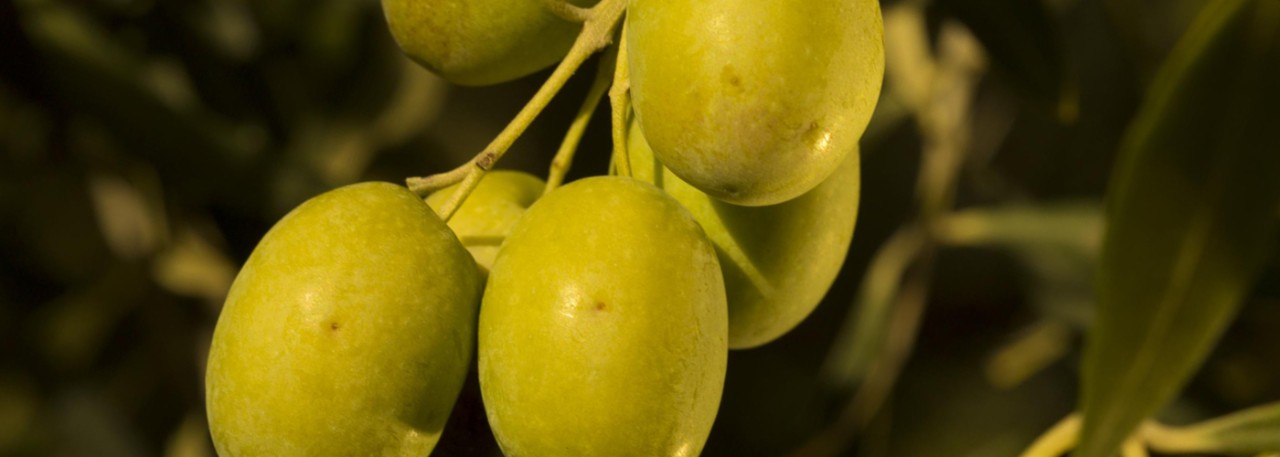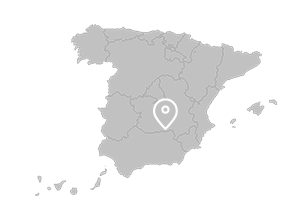.png.transform/rendition-xs/image_image%20(1).png)
Aceite Campo de Montiel PDO
Extra virgin olive oil obtained from olive tree fruit, from the Cornicabra, Picual, Manzanilla and Arbequina varieties by mechanical procedures or by other physical methods that do not tamper with the oil, preserving the flavor, aroma and characteristic features of the original fruit.
Tasting notes
A balance is maintained in the oils, keeping a uniform and proportional line, both in terms of fruit and in their bitter and spicy intensity. The predominant varieties, Cornicabra and Picual, give the oils a particular bitter and spicy flavor, which is a positive attribute in olive oil. In tasting and aroma assessment, their bitterness factor is between 3 and 6 and spiciness between 3.4 and 6.3, with some hints of apple and almond, which is typical of other varieties.
The fruity olive flavor (both green and ripe) is present in all the protected oils, with hints of green or ripe fruit depending on the time of year when the olives were collected, although both may be present together. The oils made in early December from Picual olives, or the oils obtained from Cornicabra olives at the end of December, have primarily green fruit flavors, becoming riper as the harvesting season progresses, up to late January.
Other notes
Physical, chemical and organoleptic properties:
-Average flaws = 0
-Average fruitiness ≥ 2.5
-Maximum acidity (% of oleic acid) = 0.5º.
-Maximum peroxide index of 15 m.e.g. of active oxygen per kg/oil.
-Ultra-violet radiation absorbance: K270 ≤ 0.20, K232 ≤ 2.50
-Sum of moisture content and impurities ≤ 0.1 %
Production / Processing method
Approximately 90% of the olive groves in the DO area are on land with no artificial irrigation. Generally speaking, the irrigated plots are new plantations with drip feed irrigation systems. Olive groves in the area have an average age of between 40 and 60 years, with some groves being over a hundred years old.
The pruning system used is the so-called traditional method, carried out twice a year, mainly with a chainsaw and to a lesser extent, an axe.
Harvesting in this area is traditionally done with a hand vibrator together with sticks, or with sticks, or using a vibrator with a mat from a tractor.
The olives are collected when they are at their ideal stage of ripeness, and it is compulsory to separate the fruit harvested from the tree from those that fall to the ground naturally. The olives destined for producing the protected oils are obtained exclusively from tree harvesting; olives on the ground are discarded, as they produce lower quality oils.
The transport system used is always in bulk, in boxes, in trailers or in limited capacity rigid containers in order to prevent the fruit being damaged or spoiled. The trailer or container must be cleaned with a high pressure jet of cold water before each load. To prevent fermentation (known as atrojado) in the field, no more than 24 hours may elapse between harvesting the fruit and delivery to the oil mill.
When the batches of olives arrive at the oil mill, a visual inspection is carried out, after which the olives are placed in the underground receiving hopper, from where they are taken on conveyor belts to the cleaning equipment. In this stage, jets of air are used to separate the olives from leaves, twigs, small stones, small-sized olives, etc. After this, the olives go through the washing stage, using water. This stage is carried out to eliminate any dirt sticking to the olives that was not fully removed at the cleaning stage.
Later, the fruit is weighed and the batch is registered, recording the name of the supplier, the quantity in kilos, the municipality where the olives came from and the variety if the batch is homogenous.
After this, the olives are stored in waiting hoppers and from there they are taken to the hammer mill, where the tissues are broken down and the oil inside them drips out. Grinding is carried out within a maximum period of 24 hours after the olives arrive at the mill, as otherwise they will start to ferment and this would affect the quality of the oil.
The paste obtained from grinding is taken by conveyor belt to a mixer equipped with a heating system and various sizes of paddles that turn and mix the paste, preventing emulsions forming that would adversely affect the amount of oil produced and its quality. This stage lasts no longer than 90 minutes, and the temperature of the paste varies from 25-30ºC / 77-86ºF. Adding water and technological emulsifiers in the beating process is only allowed in cases where the paste is difficult to treat (because it is excessively dry or moist) and the quantities used must be between 0.5% and 2.0%. After beating, the various components are separated.
This process is carried out in a horizontal centrifuge or decanter, where the oil and the solid elements are separated by centrifuging. Water is normally used in this stage to make the paste more fluid. The temperature must not exceed 35º C / 95º F. The decanting area is normally separated from the other areas in the oil mill and kept at a temperature of around 20º C / 68º F, enabling the best possible result to be obtained from the decanting process. Cellar temperatures are kept at around 15 - 20º C / 59 - 68º F. Processing and packaging of stored oils must be done within the defined geographical area.
The packager must have systems that enable the DO oils to be packaged separately from any other oils that may be packaged on the site. They must also have approved systems for measuring the oil.
Packaging is done in containers of five liters or less, in the following materials: glass, plastic, PET, metal, china and ceramic.
Geography / Relief and climate
The Campo de Montiel is a chalk high plain covering over 7000 km2 / 2702.7 mi2 at an average altitude of 850 m / 2788.7 ft. It is a physically homogenous region, with its own specific features and peculiarities with respect to other neighboring regions, and is mainly a farming area.
The soil is typically brownish red and brownish lime, mostly composed of calcium carbonates and very healthy.
In terms of climate, the region is given to extremes of weather, with major differences of temperature, ranging from long, very cold winters and hot summers, many hours of sunshine, extremely bright light and low rainfall (600-700 mm / 23.6-27.5 in).
Regulatory Council
Association for the Promotion of the DOP Aceite Campo de Montiel
C/ Monjas y Honda, 4 - bajo
13320 Villanueva de los Infantes (Ciudad Real)
Castile-La Mancha
Tel: (+34) 926 350 545
direccion@doaceitecampodemontiel.es
www.doaceitecampodemontiel.es
Sources:
- Spanish Ministry of Agriculture
- Association for the Promotion of the DOP Aceite Campo de Montiel
The predominant varieties, Cornicabra and Picual, give the oils a particular bitter and spicy flavor.


- Aceite de Campo Montiel 1
- Aceite de Campo Montiel 2

Villanueva de los Infantes (Castile-La Mancha)
